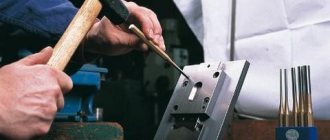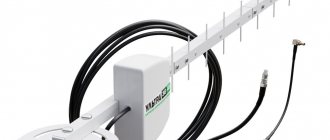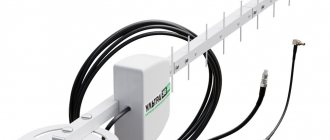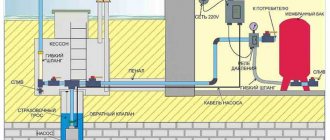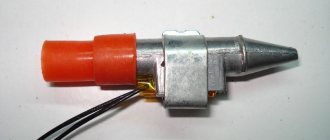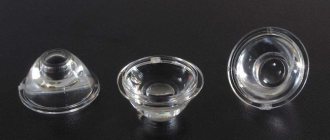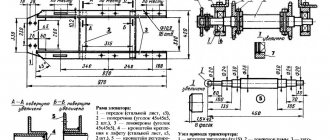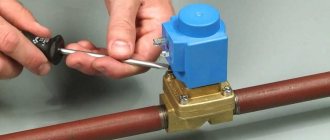DIY rolling jack
Required tools:
- Grinder (angle grinder) with cutting disc for metal
- Drill with metal drills
- Welding machine
- Wrench
Materials for assembly:
- Channel 10P – 800 mm (at stop)
- Channel 10P – 700 mm (on base)
- Channel 12P – 330 mm (on edge)
- Channel 12P – 150 mm (“swing” for jack)
- Metal rod from 12 mm Ø – 900 mm (for stiffness angle)
- Bolts and nuts M16 – 3 pcs.
Suction filter
This element cleans the working fluid coming from the storage tank to the hydraulic pump from foreign impurities. This filter, which is installed directly at the outlet of the storage tank, must prevent solid impurities contained in the working fluid from entering the pump line. Since the suction capabilities of the hydraulic pump are limited, the filters located between it and the storage tank must create minimal resistance. Suction filters, some models of which include a magnetic separator or bypass valve in their design, provide only rough cleaning of the working fluid.
Design of some filters for oil stations
Filler neck
The neck is equipped with an air filter that prevents foreign impurities from entering the working fluid at the moment when the hydraulic tank is opened.
Measuring devices
This includes pressure gauges and indicators of the amount of working fluid in the hydraulic tank.
Switchgears
These elements can be one of two types: electro-hydraulic and manually controlled (such devices can consist of one or more sections).
Types of homemade press designs
First of all, it is necessary to consider possible options for making homemade equipment. An important component is the mechanism for creating increased pressure. You should also pay attention to the shape of the frame and the configuration of the support table.
To make a manual or mechanical hydraulic press with your own hands, first select a power unit. Often a jack is used for this. Its maximum load capacity will determine the degree of pressure on the workpiece. The value of this parameter depends on the type of work performed. For use at home, you can choose a jack model with a lifting capacity of 7 to 20 tons.
Oil station NEE16-20I100T1 for hydraulic cylinder control – price, description, drawings, hydraulic diagram
The NEE16-20I100T1 oil station is designed for long-term operation and is equipped with a large-volume tank. It is equipped with a pressure switch on the power stroke and idle lines, which allows the operator to adjust the forces of the actuators (hydraulic cylinders) within a wide range, making the use of the oil station very flexible and technologically advanced. The powerful asynchronous motor of the oil station ensures smooth operation under conditions of heavy overload. Using a pressure switch and an automation unit, you can set the required force of the hydraulic cylinders, which allows you to use the station in various technological processes and allows you to gain control over the actuators.
Culinary uses of a jack press
At the first stage, an accurate drawing is made, which should include all design elements. Their operational and technical characteristics are taken into account - overall dimensions, steel thickness, load capacity.
Before this, you need to choose the optimal set of tools and consumables. To process and weld metal structures, you will need a welding machine, a powerful drill, and a set of bolts and nuts. Blanks for a manual hydraulic press can be formed using a self-generator or an angle grinder. In order to secure the unit, holes will need to be made in its base.
Recommendations for assembling the machine:
Frame. The frame consists of 6 channels. The connection is made in two ways: welding and mechanically using screws;
auxiliary table. The optimal design is to install two channels with a gap between them;
Pipeline
This is a system of channels, which may include high-pressure hoses, metal pipes, special plates mounted on a butt or modular principle. The pipeline with which each oil station is equipped simultaneously performs several important functions:
- connects the hydraulic pump to the working parts of the oil station (control, distribution and regulating equipment);
- ensures the process of pumping working fluid to the executive body;
- is responsible for returning the working fluid back to the hydraulic tank.
High pressure pipelines
Manufacturing process
When the drawing of your future hydraulic press is ready, and all the necessary materials, tools, equipment and components are available, we proceed directly to manufacturing. The first thing to do is to cut all the metal, guided by the dimensions indicated in the drawing.
One of the drawing options for making a press
Now you need to make the base of the press, for which prepared square pipes are welded together, and a steel plate is welded onto the rectangle formed from them. Then the side and top parts of the frame are welded together, carefully ensuring that the resulting U-shaped structure is smooth and has strictly right angles in the joints. Now the resulting structure should be welded to the base and we can assume that the frame for your hydraulic press is ready.
The next element that you will need to make for the press is a movable platform. To make it, you can use a channel, square or rectangular pipe. A piece of pipe is welded in the central part of the platform, which will serve as a socket for the head of the jack rod. To make guides for the working platform, you will need two steel strips, the length of which must correspond to the width of the press frame along its outer contour.
A variant of the press design with a movable lower platform, which is fixed with bolts
The strips are attached to the sides of the mobile platform using bolted connections, having previously brought it inside the frame. A removable stop is made using the same scheme, but holes are drilled in its guide strips opposite the frame posts to fix it at the desired height. The process of making a hydraulic press with your own hands is completed by installing tension springs and the jack itself. Such a hydraulic press is also convenient because you can always remove the jack from it (for example, if you need to use it to repair a car).
Appearance of a finished homemade press
One of the fairly economical variations of a hydraulic press, made with your own hands in your garage using simple devices, welding, a jack and channels.
Communities › Homemade Garage Hi-End › Blog › Hydroelectric station
As they say, “due to business needs,” a need arose in production for a hydraulic station from which various hydraulic tools could be powered: hydraulic cylinders, presses, sheet benders, hydraulic motors, etc.
In general, this project has been brewing for a very long time, the first parts for it were purchased two years ago, but since there was no urgent need for such a device, the project remained in a dormant state. However, its time has come... This is one of the few projects that we built without any preliminary drawings. As they say, in place and from scraps. To be honest, this is hell (although almost everyone I know works this way). On the one hand, it seems like progress is immediately visible, but you also have to redo it 100,500 times, because you don’t foresee one thing, then you forget another... But you can feel like an Artist.
The engine was 2.2 kW at 1400 rpm (AIR90L4). The use of NSh type pumps was immediately abandoned due to the unclear situation with their quality and the real chances of running into outright defects. Instead of the NSh, we used a Taiwanese pump RG P2 with a displacement of 4 cm3, delivering a pressure of 250 bar (which is 1.5 times more than that of the NSh). The pump was connected to the engine through an adapter bell and a coupling with a polyurethane insert, fortunately all this stuff is standard, easy to buy and does not require any manipulations like “cut a piece from one part and weld it to another,” as happens with NSh.
Under the engine, we welded a mighty frame from 80x40 channel bars, the remains of which were gathering dust lonelyly in the corner. Cutting sheets 2mm thick were used on the tank.
We assembled everything first on oven mitts. Firstly, it’s easier to redo everything when something goes wrong (and I had to redo it often). Secondly, this is a way to force yourself to paint the product before using it. Usually, when everything is already assembled, there is no desire to disassemble everything and paint it, so half of the devices in our workshop can serve as sets for a film about a post-apocalyptic future. And when assembling on tacks, everything will have to be disassembled for welding, and at the same time painted.
We figured out a panel for installing the hydraulic distributor. We only had a single-section one in stock, but in the future there are thoughts of putting a distributor into 3 sections in order to get 6 working circuits and be able to connect up to 3 consumers to one station (one day this will definitely be needed).
Next, we installed the main filter and found a place for the starter to the engine. At first, they thought of placing the ports for connecting hoses next to the distributor, but then it became clear that this was not a very good idea, and in the final version everything moved down to the wheels
We put the device on wheels and began to figure out how to connect the hoses. This is where all the shortcomings of the “artistic” approach came out. Hydraulic hoses are quite rigid, so it is not always possible to connect them as originally intended. After some torment and alterations of the hoses, everything was connected like this.
Literally it immediately became clear that this was not a very successful configuration, and the BRS was moved downstairs. Otherwise, almost a meter of hoses of the connected tool would be “eaten up” due to the fact that the connection point is too high above the ground. The configuration was revised, and the BRS moved downstairs.
Then everything was disassembled, scalded, sent for painting and we suffered for two whole days waiting. Finally it's time for the final assembly.
Classic design
For production you will need:
The bottle lift itself;
- Channel;
- Steel sheet 4-5 mm thick;
- Two steel springs.
- The frame is welded from durable channel 5 mm thick. The corners are reinforced with brackets and anchors made of steel sheet of similar thickness.
Points of maximum pressure should be strengthened. To do this, the heels can be welded from a steel sheet. They are installed on the upper platform and on the moving element.
It is also recommended to install stops on the moving element to prevent the jack from slipping out.
The moving element is suspended on springs. Guide flags are welded to the ends, preventing vertical movement of the platform.
Construction is ready. The jack can be removed at any time and used separately from the press. Having a set of accessories (bushings, dies, first select the power unit with your own hands. A jack is often used for this. Its maximum load capacity determines the degree of pressure on the workpiece. The value of this parameter depends on the type of work being performed. For home use, you can choose a jack model with a load capacity from 7 to 20 tons.
Press with hydraulic cylinder and pump
An alternative option is to install a hydraulic cylinder and a pressure pump. This will ensure maximum comfort when doing work. But the cost of such a do-it-yourself design is much higher than that of a car with a jack.
The machine body is often made of steel channels and angles. The thickness of the material must be at least 2 mm. The design of a homemade hydraulic press with a jack or cylinder consists of the following components:
jack mounting block. Its movable rod can be placed in both the upper and lower parts;
auxiliary table. The workpiece will be installed on it. When making it yourself, it is recommended to provide for the possibility of changing the height relative to the jack;
Frame. A power unit and a support table are installed on it. At the bottom there are height-adjustable legs for greater stability.
It is not recommended to provide detailed construction drawings as different components may be used in its production. However, it is recommended that you familiarize yourself with the factory analogues in advance, based on the data received. in order to develop an optimal model.
Specially shaped fittings are used for various types of work. They must be made of durable tool steel, so making them yourself will be problematic. It is recommended to order from a professional turner.
Simple drawing of a hydraulic press
Classification
Extensive experience in the creation and operation of various hydraulic drives has shown that only limited types of pumps can develop high pressure. These include piston and plunger types. The hydraulic pump drive comes in three design types:
- manual (muscular);
- mechanical;
- pneumatic.
The use of hydraulic drives with ultra-high pressure (over 70 MPa) makes it possible to significantly reduce the dimensions and weight of equipment and increase its specific performance. The development of high-pressure systems is one of the key factors in the creation of compact, powerful hydraulic drives and mini-equipment for various sectors of the economy.
Home use options
The use of a hydraulic press in a garage or home workshop is quite common. This type of press, which is small in size, can be used both for car repairs and for other types of work.
In particular, with the help of such compact equipment it is possible to press out bearings or silent blocks, as well as press new parts in their place. In addition to automotive repairs, a hydraulic press can be used for bending metal parts, creating the required pressure when gluing surfaces, briquetting waste, and squeezing out oil and liquid. Factory equipment for this purpose (even a manual hydraulic press) costs a lot of money, and not everyone can purchase it. Meanwhile, you can make such a press with your own hands, spending only money on purchasing the necessary materials.
Using a press as a juicer
What is noteworthy is that the design of a hydraulic press manufactured at home can immediately be adapted to solve a specific problem with a specific part or workpiece. A self-made press will not take up much space; to place it, it will be enough to allocate some space in a workshop or garage. Detailed instructions on how to make a hydraulic press are given below. There is also a video on this topic at the end of the article.
Operating principle of the oil station
The main task of the device is to convert energy using compression and liquid flows.
The device functions as follows:
- the engine transfers energy through the rotation of its shaft to the hydraulic one;
- the pump draws the solution from the reservoir using filtration;
- the liquid spreads to the components of the device using pipes, they contribute to its uniform distribution, pressure and supply to the cylinder and motor;
- The working fluid makes a circle in the device and flows into the container using a drain filter.
Advantages of an oil hydraulic station
Instead of an oil system, you can use compressor units, but over them, an oil station has a number of irrefutable advantages.
- Price. The system is compact, which saves money on transportation and installation.
- Cost. The oil system significantly reduces electricity consumption.
- Performance. Hydraulic oil stations are more powerful and efficient.
- Noise. The unit operates much quieter than compressor units.
- Ease of use. Does not require the services of additional specialists.
Hydraulic oil systems are used in various fields due to their versatility and universal design. Thus, they can be used for:
- electrical installation equipment;
- railways and construction sites;
- slurry pumps and pumping stations;
- lifts for large loads.
The principle of operation of a hydraulic station is to pump a substance under compression, so they are used in the case of preliminary tests of pipelines, hydraulic cylinders and various types of equipment. Most often used in the fields of mechanical engineering, metallurgy, agriculture, transport and energy.
Tools and materials
If you are going to make a hydraulic press with your own hands, then you will need the following tools, consumables and equipment:
- welding equipment;
- electrodes;
- metal hacksaw or grinder (angle grinder).
In addition, you will need the following elements that will make up your future garage press: a hydraulic jack, two springs that will pull the movable platform to its original state. If you find an old bridge fungus in your garage left over from a renovation, it can be used as an element of a pulling device for homemade presses with a lower jack. In this case, the fungus is put on the jack rod, the upper part of the springs is attached directly to it, and the lower part is fixed to the frame.
The type and quantity of materials required to build a press greatly depends on the chosen design option.
In order to make a press from a jack, you will need the following rolled metal:
- channels (no less than 8 numbers), rectangular or square pipes (with dimensions no less than 40x40), corners with a shelf width of no less than 50 mm;
- a steel sheet with a thickness of at least 8 mm, which will be used as a reliable foundation for the entire structure;
- a piece of steel strip 10 mm thick - for the manufacture of guides and stiffeners, if necessary;
- a piece of pipe - for making sockets for the head of the jack rod.
Filtration system
To ensure continuous operation of the hydraulic station without breakdowns, it is necessary to keep the working fluid clean and remove foreign particles and debris from it that have entered during circulation through the system. Otherwise, moving parts may jam and various elements may wear out too quickly. This reduces the power of the station and leads to unreasonably high repair costs.
Complex hydraulic equipment with a large number of control elements requires multi-stage oil filtration. The choice of filter characteristics and installation locations depends on the parameters of the hydraulic system.
The following options are possible:
- For general-purpose hydraulic power stations and one-time-occasional operation, it is possible to install filters with a cleaning fineness of 80 microns;
- For hydraulic power stations with more intensive operating modes, 25 micron filters are installed;
- For equipment with automatic control systems based on proportional hydraulic valves, 10 micron filters are required.
Filter elements are installed in the suction, drain or pressure lines, or in a separate cleaning circulation circuit. They are mounted in such a way as to provide easy access for dismantling and replacing the filter element. It is recommended to use devices with a contamination indicator, which simplifies monitoring the technical condition of the degree of contamination.
In the diagram, the filters are numbered 3 (pressure), 4 (suction) and 5 (drain).
Construction of a homemade garage press: design characteristics
Before making a hydraulic press, you should decide on the type of installation. Depending on this, the equipment can be desktop or floor-standing. The first type of tool is located on a workbench, and the second is placed on a special pedestal. Such presses differ in size and load capacity. A self-made tabletop hydraulic press provides a force of up to 12 tons, and for a floor-mounted device this value reaches 25 tons.
The desktop design is more stable and mobile. Thanks to its small size, it does not take up much free space. This type of press is used for processing small workpieces.
The floor-mounted hydraulic press is characterized by its large size and heavy weight. To install it, you will need to build a special platform. Such a machine will cope with processing large metal elements, disassembling and assembling complex components.
A self-made hydraulic press for a garage can have a vertical or horizontal design
Important! To expand the functionality of a floor-mounted hydraulic press, it should be equipped with an electric motor.
You can make a complex structure that will be used to perform a wide range of tasks. However, making such an option will take a lot of time and require the use of specialized tools and equipment. As a garage hydraulic press, it is better to make a manual model equipped with a hydraulic pump and drive. This design is two-speed, its piston is characterized by mobility.
A self-made hydraulic press for a garage can have a horizontal or vertical design. The first type of device is used for straightening, cutting and bending individual metal elements. Vertical equipment is designed for unpressing and pressing parts. A self-made hydraulic press for waste paper is becoming increasingly popular.
Hydraulic distributor
The hydraulic distributor (number 7 in the diagram) is necessary to change the direction of the flow of working fluid to the hydraulic cylinders or stop the flow. With their help, you can change the direction of movement of the actuator. For example, moving the piston of a hydraulic cylinder in the forward or reverse direction, as well as rotating the hydraulic motor.
Hydraulic distributors can be of several types:
- Manual;
- Electromagnetic;
- With pilot pneumatic actuator;
- With pilot hydraulic drive;
- Proportional.
They differ from each other in nominal diameter - 6, 8, 10, 16, 20, 25 and 32 mm.
In oil stations, spool-type distributors are most often used. They are cheap, compact in size and highly reliable. Withstand high pressure of working fluid (up to 350 bar) and high speed (up to 1100 l/min).
The procedure for manufacturing a hydraulic press
Today, there are quite a large number of drawings that allow you to make a hydraulic press with a jack with your own hands.
A homemade press will not differ from real equipment produced at the enterprise.
This way, you can save money and have high-quality equipment at your disposal that can be easily improved and modified in the future.
At home, using a homemade press, you can iron any objects, including metalworking waste. Many craftsmen use the press primarily for deforming pipes and bending profiles. Since a hydraulic press for home purposes is made with your own hands, you can use a regular garage instead of a workshop.
- It’s quite simple to assemble a homemade press on your own, but you need to prepare all the necessary tools in advance. It is necessary to prepare a welding machine and a large number of electrodes. If you do not have welding skills, you can turn to specialists for help for a small fee.
- A grinder will also be needed for metal processing of some parts. The main raw materials for making a hydraulic press are metal profiles, which can be purchased at any DIY store. There is no point in buying a large amount at once.
- It's better to buy everything as needed.
The first thing to keep in mind is that the operating principle of a hydraulic press is pressure, which can be obtained either manually or using a pump. Pressure can also be applied to the slave cylinder by installing a hydraulic jack that already has a built-in hand pump.
Jacks can be of different types, but it is better to choose a bottle-type model, since over the entire period of use they have shown the longest service life.
When installing a hydraulic press, make sure that the jack is installed only vertically and the jack rod cannot be lowered down.
For household use of a hydraulic press, a minimum load force of 10-20 tons is sufficient. The higher load force is used only in production.
Related Posts
Please advise a hydraulic station for synchronous operation of hydraulic cylinders.
- Author: Daniil Gordienko
- February 15, 2022 1 comment
A hydraulic station is needed for the synchronous operation of hydraulic cylinders. Please advise what and how to choose?
Why does the hydraulic station not produce the required pressure, what should I do?
- Author: Kirill Erlikh
- February 15, 2022 1 comment
The hydraulic unit does not produce pressure, what should I do?
Questionnaire for ordering a hydraulic station: what parameters do you need to know to order and manufacture a hydraulic station?
- Author: Sergey Mikhailov
- February 15, 2022 1 comment
What parameters must be specified to order a hydraulic station?
Hydraulic power stations for hydraulic tools: features and differences
- Author: Alexey Kramarenko
- February 15, 2022 2 comments
What is the peculiarity of hydraulic power stations for hydraulic tools, how do they differ from conventional hydraulic power stations?
DC hydraulic station 12/24V for hydraulic press
- Author: Yakov Damsky
- February 15, 2022 1 comment
Please tell me, is it possible to use a 12/24V hydraulic station to operate a hydraulic press?
Consultation with a hydraulic engineer
- Author: Denis Tolstosheev
- September 11, 2022 no comments
Good afternoon, please tell me how I can get advice on the topic of hydraulic components? I am interested in issues related to the diagnostics of the hydraulic system and, in general, the purchase of hydraulic pumps/hydraulic motors/hydraulic distributors, selection of analogues, etc. I don’t want to make a mistake in choosing, but I have very little experience, I don’t know what to pay attention to.
Oil for hydraulic power station: what kind of oil should be poured into the hydraulic power unit? Can I use a non-hydraulic one?
- Author: Vladimir Volosatov
- February 20, 2022 1 comment
What kind of oil should I pour into the hydraulic station?
What is hydraulic fluid?
- Author: Vyacheslav Makarov
- February 11, 2022 no comments
Hydraulic fluid is a kind of energy transfer mediator used in all hydraulic systems. However, the functionality of hydraulic fluid is not limited to simple energy transfer. Although transmitting hydraulic power is the primary purpose of hydraulic fluid, it also performs four auxiliary functions: heat transfer, contaminant removal, sealing, and lubrication.
Under normal conditions, hydraulic machines produce enormous amounts of excess heat, often caused by inefficiencies in the components themselves, such as pumps and motors. Without the ability to dissipate heat from these components, they can easily overheat, causing damage to valves and internal components, especially in low local viscosity environments. When the oil returns to the reservoir, it passes through a cooler many times, which keeps it at an optimal temperature until it is returned to the hydraulic system. Conversely, hydraulic fluid can be used to provide heat to the system during idle starts when needed.
We turned off the tractor, started it up the next day - neither the steering wheel nor the hydraulics worked. What could be the reason ? Amkador 342v
- Author: Arthur Petrosyan
- 01 July 23:49
Good evening, can anyone help? Advice or something else? I worked all day. They turned off the tractor the next day and started it up. The steering wheel doesn’t work. The hydraulics have all failed! What could be the reason ? Amkador 342v
Hydraulics. Why does the grab rise by itself?
- Author: Zulfir Tukhbetov
- March 27 15:38
Hello guys, please tell me the hydraulics lifts the grab by itself
Downhole piston pump
A manual piston pump is assembled from improvised means in the following order.
- Frame. Made from metal pipe. The length of the latter can be chosen within 60-80 cm. The diameter of the cylinder must be at least 80 mm. To ensure easier movement of the piston along the cylinder, it is recommended to turn the pipe on a lathe. A hole is made in the side of the body and a pipe is installed to drain water.
- Brackets. They are welded to the pump body to install a lever on them. You can make brackets from a corner.
- Lid. The pump cover is made of sheet plastic or metal. A hole is made in it for the rod. You also need to make a bottom cover and install a check valve on it. It is necessary to weld or screw a pipe to the bottom cover to which the water intake pipe will be attached.
- Piston. The piston can be made of metal, plastic or wood. It has the shape of a plate and consists of two parts: a body 20-30 mm thick and a piece of rubber that covers it. Several holes with a diameter of 10 mm must be drilled in the piston body. These holes are covered with rubber, which will act as a valve. A hole is made in the center of the rubber for the rod. The piston itself is attached to the latter.
- Bottom valve. The intake valve can be made of thick rubber or other heavy material. The valve must be cone-shaped and close the inlet. A guide should be installed in the center of the valve, allowing it to return to its original place after opening. Below is a drawing showing the valve installation locations.
- Pump rod. Can be made from metal rod with a diameter of up to 10 mm. One end of the rod is attached to the piston, and the other to the lever.
- Lever arm. To make a lever, a pipe with a diameter of 3 cm is suitable. The upper part of the pipe should be flattened and a hole should be drilled in it for a bolt, with which the rod will be secured. A hole is also drilled in the middle part of the pipe. It is needed to secure the lever between two brackets using a long bolt.
When all the parts are ready, all that remains is to assemble the pump:
- connect the bottom cover to the body;
- insert the lower check valve into the housing;
- insert the piston with rod;
- close the top cover;
- install the lever;
- connect the water intake pipe to the bottom of the pump and lower it into the well or borehole;
- secure the pump to the platform.


